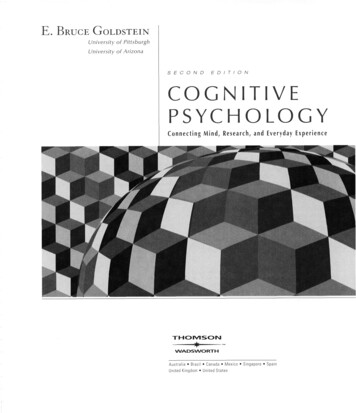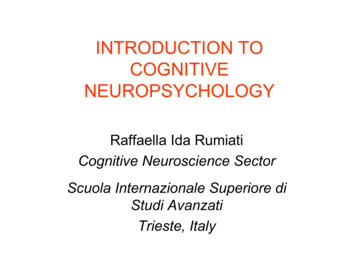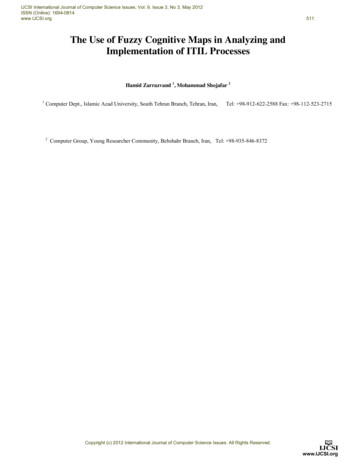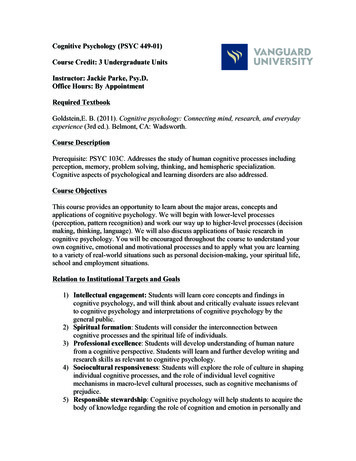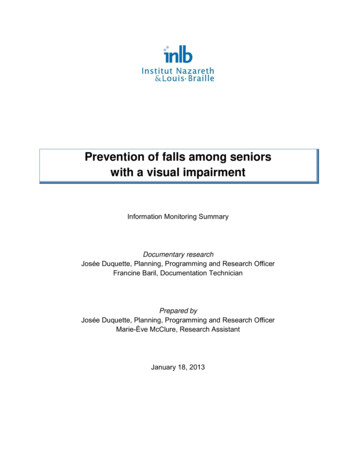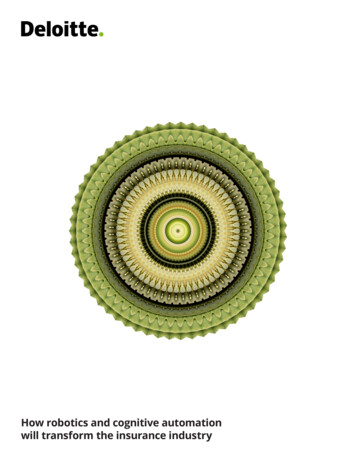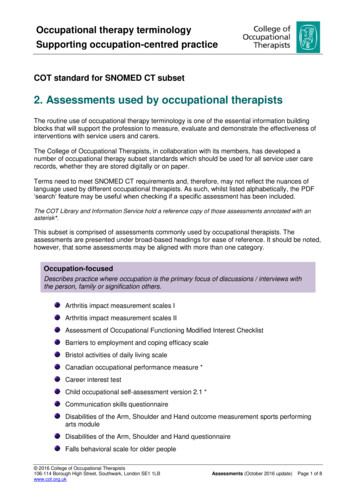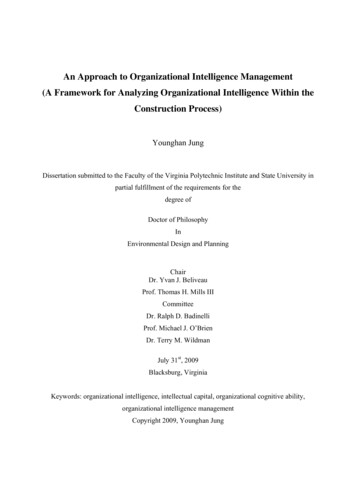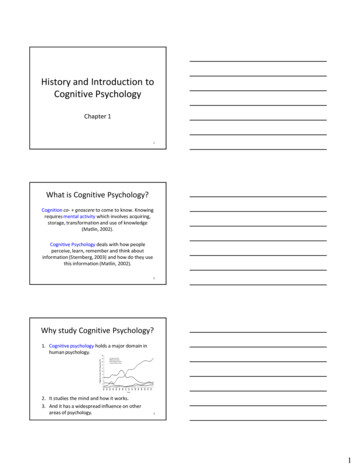
Transcription
History and Introduction toCognitive PsychologyChapter 11What is Cognitive Psychology?Cognition co- gnoscere to come to know. Knowingrequires mental activity which involves acquiring,storage, transformation and use of knowledge(Matlin, 2002).Cognitive Psychology deals with how peopleperceive, learn, remember and think aboutinformation (Sternberg, 2003) and how do they usethis information (Matlin, 2002).2Why study Cognitive Psychology?1. Cognitive psychology holds a major domain inhuman psychology.2. It studies the mind and how it works.3. And it has a widespread influence on otherareas of psychology.31
History of Cognitive PsychologyGenerally speaking two approaches have been usedto study the mind.1. Historically, philosophical approaches haverendered an understanding to the workings ofthe mind using introspection.2. And biology, has used observational (andempirical) methods to study the mind.4Mind & RealityPlato (ca. 447-327 BC)Reality does not residein concrete objects butin abstract formsrepresented in ourmind.Aristotle (384-322 BC)Reality lies only in theconcrete world ofobjects accessedthrough the ng of mind (orknowledge) through logicalanalysis and introspection(rationalism).Observations of theexternal world are the onlymeans to arrive at truth(empiricism).Innateness of mind ormental faculties.Acquired experiencesthrough interaction withthe environment.Theory building inpsychology today.Experimentation inpsychology today.62
Seventeenth CenturyRene Descartes (1596-1650)John Locke (1632-1704)Descartes agreed withPlato and emphasizedreflective methods(rationalism) overobservation to studymind.Locke favored Aristotleand emphasizedobservation as amethod (empiricism) tostudy mental processes.7Immanuel KantIn eighteenth centuryGerman philosopherKant addressed the issueof rationalism andempiricism and said thatboth approaches must beused to decipher truthand about reality ofmind.(1724-1804)8Structuralism1. First psychology lab inLeipzig, Germany (1879).2. To analyze the structureof the mind. Through themethod of introspection.3. Elements of mind:sensation, feelings, andimages.Wilhelm Wundt (1832-1920)93
Functionalism1. Mind or consciousnesscannot be divided intoelements.2. Introspection cannotyield measures about themind.3. Mind or consciousnesshave adaptive value.William James (1842-1910)Self-portrait10Behaviorism1. No room for mind orconsciousness.2. Overt behavior needs tobe the scientific domainof psychology.3. Behaviorism is anextreme form ofassociationism betweenenvironment (S) andobservable behavior (R).John Watson (1878-1958)11Gestalt Psychology1. Opposed behaviorismand structuralism.2. S-R components ormental elements couldnot explain behavior ormind of an individual.3. Holistic approach tounderstanding behavioror mind.Wolfgang Kohler (1887-1967)124
Associationism1.2.3.Studied “highermental processes”, likememory andforgetting.Used systematicexperimentalintrospection.Followed Aristotelianlaw of association.Repetition improvesmemory.Hermann Ebbinghaus (1850-1909)13Memory StudiesEbbinghausBartlettIn the late 19th and early 20th century we see differences inapproaches to the problem of memory. Ebbinghauspromoted quantitative study of memory using nonsensematerial, Bartlett on the other hand used qualitativemethods to study memory.14Is the debate over?Certainly not! Understanding mind and its realityhas its adherents belong both to nurture (acquiredmind) or nature (innate mind) or both domains.155
Early Beginnings of CognitivePsychology1. Lashley’s researchshowed that largeamounts of the braincould be destroyedwithout affectinglearning.2. Hebb, Lashley’s studentproposed stimulation(learning) led to formingstrong connectionsamong neurons calledcell assemblies.StimulusResponseBrainCell Assembly16Birth date of Cognitive Psychology1. Cognitive psychology wasborn on Sep. 11, 1956,when Neisser, Miller, andSimon read seminalpapers at a symposium atMIT.Ulric NeisserGeorge Miller2. Neisser wrote the firstbook of CognitivePsychology (1967).3. Defined how people learn,structure, store and useknowledge.Herbert Simon17Computer Sciences1. In 40s and 50s, electronicengineering and computersciences starteddeveloping machines andprograms that mimickedhuman learning andthinking.2. Turing developed a test(Turing test) for acomputer to think like ahuman.Alan Turing (1912-54 )186
1960sA number of sciences and disciplines likepsychobiology, linguistics, anthropology, computersciences and artificial intelligence started gatheringdata that developed the strong foundations ofcognitive psychology.19Current Trends in CognitivePsychology20Cognitive ScienceCognitive science is a broad category of looselyassociated disciplines that include psychology,philosophy, computer science, linguistics,anthropology, neuroscience and of course cognitivepsychology is also a part of its domain.Most researchers are likely to work in aninterdisciplinary fashion.217
Cognitive NeuroscienceCan we explain cognitive processes by studying theanatomy (structure) and physiology (function) of thebrain?The field of cognitive neuroscience expandedaround the 1980s when neuroscientists startedusing imaging techniques on people performingdifferent cognitive functions.22Neuroscientific Methodology23History of Brain LesionsHuman brain damage (gladiators) and itsconsequences were noted by Hippocrates whowrote that people’s behavior changed after suchdamage.Similar observations had been made in wars victimsin the 19th century. It was not until world war II thatphysicians started to document disorders that werecaused by damage to certain regions of the brain.248
Brain LesionsOur understanding of brain function comes largelyfrom brain lesion studies in animals. Lesion studiesprovide clues to the organization of the brain. Whichbrain region engages in what kind of cognitivefunction.Cognitive functions can remain elusive because ofrecovery of function (Lashley, 1932).25Brain Angiographyimaginis.comIs an X-ray method tolook at arteries of thebrain. Providesinformation aboutabnormalities in thebrain like strokes ortumors.Carotid artery in the brain26CT Scanimaginis.comIs also another X-raymethod that images thebrain and makes use ofmultiple X-ray photostaken with a moving X-raydevice. Finallyreconstructing a 3Dpicture of the brain.Resolution poor. Cannotdetermine structurefunction relationships.CT scan of the brain279
Magnetic Resonance Imaging (MRI)www.mgh.orgA strong magnetic pulseand moves molecules inthe brain. Motion of thesemolecules are picked upas radio frequencies andreconstructed in 3-Dimages. MRI has betterresolution than CT scans.No structure functionrelationship.MRI scan of the brain28Positron Emission Tomography (PET)www.chm.bris.ac.ukIncreased radio-labeledglucose activity isscanned in the brainwhile subjects engage indifferent cognitiveprocesses. SpatialResolution good.Temporal resolution notgood. Invasive procedure.PET scan of the brain29Functional Magnetic ResonanceImaging (fMRI)www.sciencemuseum.org.ukDetects changes in bloodflow to particular areas ofthe brain when these areasare active. It provides bothan anatomical and afunctional view of thebrain. Not invasive like PETscans and provides abetter spatial andtemporal resolution.fMRI scan of the brain3010
Event-related PotentialEvent-related potentialmeasures the brain'selectrical activity(potentials) as itcorresponds to impingingstimuli (events). Excellenttemporal resolution(faster response)compared to PET or fMRI.31Event-related PotentialSingle-Cell recordings in non-human subjects providea wealth of information on the functioning of a singleor multiple neurons. For example, Hubel & Wiesel(1960) showed responses of a single neuron in theprimary visual cortex detecting an edge (feature).32Computer Sciences3311
Computers and Mindwww.research.att.comParallels between humanmind and machines havebeen made since ancienttimes. Computer analogy isrecent. There are numberof attributes that aresimilar between computersand humans.The first electricaldigital computer34Artificial Intelligence (AI)aimovie.warnerbros.com/1. Machines or programsusing intelligence tosolve complex problems,the way humans solveproblems.2. Application will includecomputers doing medicaldiagnoses, flying jetplanes, being the sensesof the disabled.35Artificial Intelligence (AI)www.starwars.com3. AI involves making programsor devices that are efficient,flexible, and learn throughexperience. They may or maynot mimic humanconsciousness.4. Computer simulation involvesdesigning a system thatsimulates humanperformance on a selectedcognitive task.R2-D2 (Artoo-Detoo)& C-3PO (See-ThreePio)3612
Cognitive Sciences37ProcessingSerial Processing involvesprocessing of information ordata in a stage by stageformat. Time consuming.Parallel Processing on theother hand involvesprocessing information ordata simultaneously. Muchfaster.38Parallel Distributed Processing (PDP)McClelland and Rumelhart (1986) proposed thatcognitive processes must be understood in terms ofnetworks that process information in parallel.Characteristics of PDP Model1. Many cognitive processes are based onparallel operations.2. Neural activity for a cognitive process isspread out in the brain and is termed as anode.3913
Parallel Distributed Processing (PDP)Characteristics of PDP Model3. A node reaches a critical activation level toaffect another node4. When two nodes are activated the bondbetween them strengthens.5. Multiple nodes and parallel processing aidsand reconstructs information that is partial orinadequate to begin with.Node40Issues in CognitivePsychology411. Nature or Nurture?If we believe in nature affects our cognitivefunctions then we should design our experimentslooking at environmental factors as the causecognitive phenomena. On the other hand if webelieve in nurture then our experiments need tolook at innate/inborn processes.Today cognitive psychologists believe that both thenature and nurture interact to affect cognitivephenomena.4214
2. Rationalism or Empiricism?What kind of methodology should we use to studycognitive phenomena? Should we use logicalreasoning to explore cognitive phenomena orshould we engage in observation andexperimentation to do the above?3. Structures or Processes?Should we study the structure (contents, attributes,and products) of the mind or should we study theprocesses of our mind (thinking)?434. General or Specific Domains?Do cognitive processes limited to singular domainsor do they apply to multiple domains in our minds?Do processes/functions in a single domain similarto other domains?445. Causal or Ecological Validity?Should we study cognitive processes usingcontrolled [but artificial] experiments to make validcausal inferences – or develop experiments[resembling life] that provide us with ecologicallyvalid findings but at the cost of losing someexperimental control?4515
6. Applied or Basic Research?Should we study cognitive processes for the sake ofsimply understanding them or should we studythem to help people make use of them for practicalconsiderations?7. Biological or BehavioralResearch?Should we study cognitive processes by analyzingthe brain and its functions – or should we studythese processes by behavioral measures, reaction46times, errors etc?16
Cognitive Psychology deals with how people perceive, learn, remember and think about information (Sternberg, 2003) and how do they use this information (Matlin, 2002). 3 Why study Cognitive Psychology? 1. Cognitive psychology holds a major domain in human psychology. 2. It studies the mind a

